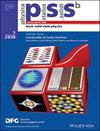低位错溅射氮化铝模板上氮化铝量子阱内部量子效率的阱数依赖性
IF 1.5
4区 物理与天体物理
Q3 PHYSICS, CONDENSED MATTER
引用次数: 0
摘要
我们评估了低位错面对面退火溅射氮化镓(FFA Sp-AlN)和传统金属有机气相外延生长氮化镓(MOVPE-AlN)模板上的氮化镓多量子阱(MQW)结构的内部量子效率(IQE)和阴极发光强度线剖面,并讨论了量子阱(QW)数量对 IQE 的影响。FFA 样品的 IQE 较高可能是由于穿线位错 (TD) 密度较低;然而,虽然 TD 密度保持不变,但 IQE 也随着 QW 数量的增加而增加。有效扩散长度随 QW 数量增加而增加,这表明 AlGaN MQW 层有助于抑制点缺陷扩散,从而导致 IQE 增加。此外,点缺陷在 TD 中的分离以及通过 TD 的点缺陷扩散可能是 FFA Sp-AlN 和 MOVPE-AlN 模板上的 MQW 在 IQE 提高率方面存在差异的原因。本文章由计算机程序翻译,如有差异,请以英文原文为准。
Well Number Dependence of Internal Quantum Efficiency in AlGaN Quantum Wells on Low‐Dislocation Sputtered AlN Templates
The internal quantum efficiency (IQE) and cathodoluminescence intensity line profile of AlGaN multiple quantum well (MQW) structures on low‐dislocation face‐to‐face annealed sputtered AlN (FFA Sp‐AlN) and on conventional metalorganic vapor‐phase epitaxy‐grown AlN (MOVPE‐AlN) templates are evaluated and the effect of the number of quantum wells (QWs) on the IQE is discussed. The higher IQE in the FFA samples is probably due to the lower threading dislocation (TD) density; however, the IQE also increases with the number of QWs although the TD density remains constant. Effective diffusion length increases with the number of QWs, indicating that the AlGaN MQW layer helps to suppress point defect diffusion, resulting in IQE increase. Furthermore, the segregation of point defects into the TDs and point defect diffusion via the TDs may explain the difference in the IQE improvement rate between the MQWs on the FFA Sp‐AlN and MOVPE‐AlN templates.
求助全文
通过发布文献求助,成功后即可免费获取论文全文。
去求助
来源期刊
CiteScore
3.30
自引率
6.20%
发文量
321
审稿时长
2 months
期刊介绍:
physica status solidi is devoted to the thorough peer review and the rapid publication of new and important results in all fields of solid state and materials physics, from basic science to applications and devices. Being among the largest and most important international publications, the pss journals publish review articles, letters and original work as well as special issues and conference contributions.
physica status solidi b – basic solid state physics is devoted to topics such as theoretical and experimental investigations of the atomistic and electronic structure of solids in general, phase transitions, electronic and optical properties of low-dimensional, nano-scale, strongly correlated, or disordered systems, superconductivity, magnetism, ferroelectricity etc.

 求助内容:
求助内容: 应助结果提醒方式:
应助结果提醒方式:


